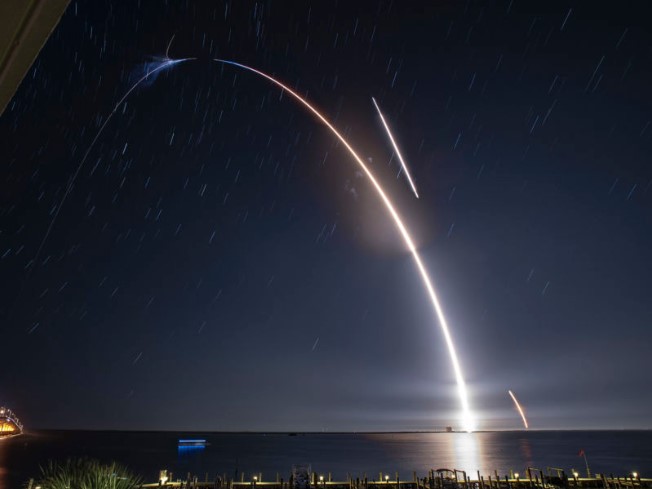
During the wee hours of Friday morning, as the clock counted down toward the launch of a Falcon 9 rocket, SpaceX engineers worked frantically at their control stations. They tracked the health of the rocket, the status of fuel loading, the nearby weather, and more for the mission to deliver supplies to the International Space Station.
“There was a lot going on, and I’ve got to applaud them because everything that was hitting the screen they were dealing with,” the senior NASA figure at the launch, Kenny Todd, recalled later during a news conference. “There was a lot of talk on the loops when you consider the weather, the wind, the issues with the drone ship, and the helium leak.”
As those last minutes ticked down, it seemed like the rain showers may have remained far enough offshore to get the launch off. Engineers also had concerns about a leak in the helium system used to pressurize the Falcon 9’s second-stage fuel tanks. They would have to monitor it all the way down to the launch, but the SpaceX team thought it should be manageable.
That left an electrical problem aboard SpaceX’s Of Course I Still Love You droneship, which lay 28km off the coast awaiting the rocket’s first stage, for the launch controllers to worry about. This issue could not be fixed without the automated ship returning to port, so if SpaceX launched early Friday night, their expensive, brand-new first stage of the Falcon 9 rocket would be lost into the ocean’s depths.
With this in mind, SpaceX went to its customer for the mission, NASA, and said it wanted to scrub. Would it be OK to wait 24 hours for the backup window? NASA had its own vested interest. The space agency had planned to reuse this Falcon 9 core for the next one or possibly for two supply missions to the station. So they agreed to scrub due to the recovery issue rather than a problem with the rocket itself. “In the end, I thought it was an OK trade,” Todd said.
A day later, the rocket launched and the first stage landed.
This is the latest example of how NASA supports innovation in US spaceflight through its commercial programs for private companies to deliver supplies and eventually humans to the station.
Flexibility and support
“NASA has been extraordinarily flexible with its interpretation of the terms of these programs,” said Greg Autry, a professor who directs the Southern California Commercial Spaceflight Initiative. “It’s another signal that the agency understands its role goes beyond fulfilling its specific mission and extends to supporting the development of a competitive space economy.”
Over the past five years, NASA has allowed SpaceX to experiment and improve its Falcon 9 rocket in multiple ways. For example, in the mid-2010s, the company used its space station missions to practice drone ship landings until, on April 8, 2016, the first stage rocket that successfully launched the eighth supply mission to the station made SpaceX’s first drone ship landing.
Recall that during SpaceX’s previous supply mission in 2015, the Falcon 9 rocket exploded during ascent. Less than a year later, on the very next mission for NASA, the agency signed off on using the Falcon 9 rocket’s margin to attempt a drone ship landing.
Against the advice of outsiders, NASA has also permitted SpaceX to use super-cooled, denser propellants on its Falcon 9 rocket. This significantly increases the booster’s performance but requires the loading of fuel shortly before liftoff.
As early as 2015, the influential chair of NASA’s Aerospace Safety Advisory Panel, Apollo astronaut Thomas Stafford, warned the agency: “There is a unanimous, and strong, feeling by the committee that scheduling the crew to be on board the Dragon spacecraft prior to loading oxidizer into the rocket is contrary to booster safety criteria that has been in place for over 50 years, both in this country and internationally.”
Nevertheless, NASA agreed to allow SpaceX to persist with these changes to its Falcon 9 rocket, and this is part of the reason that the lift capacity of the rocket has more than doubled since its first flight in 2010. These load-and-go fueling procedures will occur even during human spaceflights with the Crew Dragon spacecraft.
Not the “old” NASA
The space agency has supported not just SpaceX in this way. In 2014, when Orbital ATK (which has since been acquired by Northrop Grumman) had a stunning failure of its Antares rocket used to launch supplies to the space station, NASA accommodated two different rockets. First, the Cygnus supply vehicle moved onto an Atlas V rocket, temporarily, and then NASA stood by the company as it developed and certified the Antares 200 rocket.
The space agency didn’t have to do any of this, Autry said. “The ‘old NASA’ mode, operating under a traditional program, would likely have said, ‘Give us exactly what we ordered and don’t change anything unless we tell you exactly how,’” he noted.
NASA’s patience and openness to new ideas is all the more notable because while some improvements such as the Falcon 9’s lift capacity have benefitted the space agency, others such as rocket reusability haven’t provided an immediate benefit. “The agency is investing in keeping the United States on the leading edge of space travel, and that’s an important part of its founding mandate,” Autry said.
It’s safe to say the companies appreciate this approach. SpaceX founder Elon Musk recently acknowledged as much on Twitter, saying, “NASA support for reusability with high reliability, the critical breakthrough for orbital rockets, has made a big difference.”
























